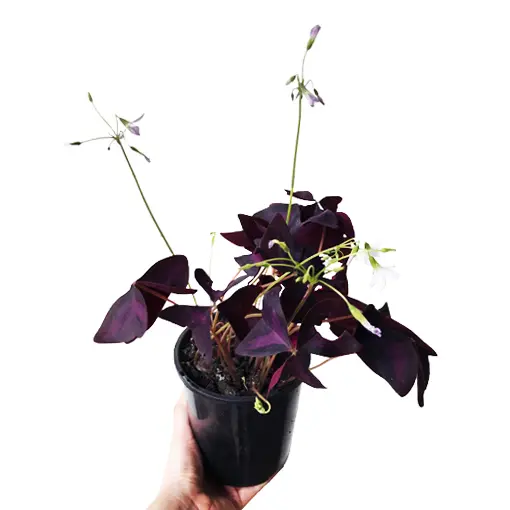Creating a diverse and captivating garden involves combining plants with unique visual elements and harmonious growth. The enchanting Oxalis Triangularis and the graceful Dypsis Lutescens, commonly known as the Areca Palm, make for a stunning pairing that adds colour and texture to your garden. This blog post explores the dynamic relationship between Oxalis Triangularis and Dypsis Lutescens, highlighting how this combination can enhance your outdoor oasis’s visual appeal and ambience.
Oxalis Triangularis: A Jewel of Uniqueness
Oxalis Triangularis, often called the Purple Shamrock or Love Plant, is a fascinating specimen known for its distinctive triangular leaves ranging from deep purple to rich burgundy. Its leaves fold at night, creating an intriguing display of movement. This plant’s compact size and captivating foliage make it a favourite for adding a touch of whimsy to gardens, patios, or even indoor spaces.
Dypsis Lutescens (Areca Palm): A Vision of Elegance
The Dypsis Lutescens, known as the Areca Palm or Butterfly Palm, is revered for its graceful feathery fronds and slender trunk. This palm species lends an air of elegance to any setting, making it a popular choice for landscaping. The soft, arching fronds of the Areca Palm create a soothing canopy of green, adding a tropical touch to your garden. Its versatility allows it to thrive indoors and outdoors, making it an ideal partner for the Oxalis Triangularis.
Creating a Harmonious Pairing
The pairing of Oxalis Triangularis and Dypsis Lutescens creates a visual contrast that adds depth and intrigue to your garden. These plants’ bold purples and deep greens play off each other in a captivating dance of colours. The elegant fronds of the Areca Palm provide a lush backdrop against which the striking leaves of the Oxalis Triangularis can stand out.
Balancing Sunlight Requirements
One of the advantages of this pairing is their similar light requirements. Oxalis Triangularis thrives in partial shade, while Dypsis Lutescens prefers bright, indirect light. Placing them together in a location that receives dappled sunlight allows both plants to flourish without competing for light resources.
Caring for Your Pairing
Caring for Oxalis Triangularis and Dypsis Lutescens requires attention to their specific needs. Oxalis Triangularis appreciates well-draining soil and regular watering, allowing the soil to dry slightly between waterings. Dypsis Lutescens prefers consistently moist soil but should not be waterlogged. Applying a balanced fertiliser during the growing season supports their health and vibrancy.
Aesthetic Appeal in Every Season
The pairing offers year-round visual interest. While the Oxalis’s leaves provide a burst of colour during the growing season, the Areca Palm’s elegant fronds remain a constant source of beauty. As the seasons change, the interplay of colours and textures between these two plants evolves, ensuring a captivating garden every season.
Elevating Your Outdoor Space
The partnership goes beyond aesthetics; it elevates the overall ambience of your outdoor space. The vibrant hues of Oxalis Triangularis inject a burst of colour and playfulness, while the graceful fronds of Dypsis Lutescens exude a sense of tranquillity and tropical charm. Together, these plants create a harmonious atmosphere that invites relaxation and enjoyment. Whether you’re hosting gatherings, unwinding after a long day, or simply taking in the beauty of your garden, the combination enriches the sensory experience of your outdoor oasis, making it a haven of serenity and visual delight.
In Nutshell
Pairing Oxalis Triangularis and Dypsis Lutescens in your garden creates a captivating display of contrasts, colours, and textures. The bold and unique foliage of the Oxalis Triangularis harmonises beautifully with the elegance of the Dypsis Lutescens. This combination adds aesthetic appeal and showcases nature’s diverse beauty. By incorporating these two distinctive plants, you can create a dynamic and visually engaging garden that delights the senses and brings a touch of elegance to your outdoor space.


